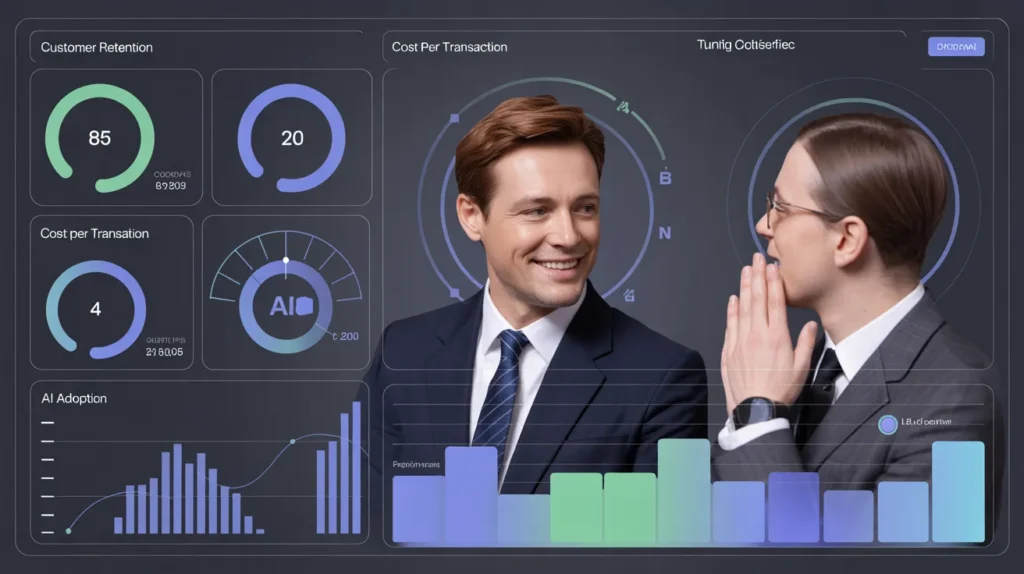Artificial intelligence (AI) is transforming business, but there’s one question on every smart leader’s mind: “How do we know if our AI investments are really paying off?” If you’re a non-technical business professional or an AI-curious executive, this guide is for you. We’ll break down how to measure AI ROI (Return on Investment) in clear terms, using real-world examples, practical metrics, and an actionable framework you can apply right away.
Why Does AI ROI Matter?
Implementing AI can feel exciting—like you’re finally stepping into the future. But as I’ve seen time and again, hype without proof is a recipe for wasted money and disappointed teams. According to Deloitte, more than half of organizations say they struggle to measure and prove the tangible business impact of their AI projects. Without clear AI ROI measurement, it’s tough to justify spending, win leadership buy-in, or make smart decisions about scaling up.
Think of measuring AI ROI as checking your car’s dashboard—not just to see if you’re going fast, but to know when to refuel, tune up, or change course.
Related Post: AI Implementation Roadmap: A Non-Technical Leader’s Guide to Turning Bold Ideas into real wins.
1. Key Metrics for Measuring AI ROI
Modern businesses need more than basic “we saved money” claims. Let’s explore the most important metrics leaders use to track and communicate AI ROI:

Efficiency Gains: Doing More in Less Time
One of AI’s biggest promises is efficiency. Whether you’re automating repetitive work, speeding up decision-making, or extending service hours with AI chatbots, saving time means saving money.
Example:
A regional logistics company used AI-powered route optimization and saved its drivers 15% in travel time each week. As a result, they needed fewer man-hours and increased on-time deliveries.
How to measure:
- Time saved per process or transaction
- Reduction in manual tasks
- Increase in the number of tasks/transactions handled daily
New Revenue Generated: Turning AI into Profit
AI isn’t just about cutting costs—it often opens up new revenue channels. Personalized marketing, smart product recommendations, and data-driven sales strategies can directly boost sales and customer spend.
Example:
According to a 2024 Salesforce report, e-commerce brands using AI-powered “recommended for you” widgets increased average order values by 12%.
How to measure:
- Growth in sales from AI-powered channels or features
- New customers acquired via AI-driven campaigns
- Revenue uplift from cross-sells, upsells, or new markets reached
Customer Metrics: Loyalty and Satisfaction as ROI
Happy customers mean sustainable growth. AI can improve customer experiences through faster service, 24/7 support, or more relevant communications.
Example:
A global telecom introduced an AI-powered virtual assistant for customer queries, reducing response time from hours to minutes. Their Net Promoter Score (NPS)—a key metric of customer loyalty—rose by 8 points in 8 months.
How to measure:
- NPS improvement after AI system rollout
- Increase in customer retention or subscription renewals
- Positive feedback or CSAT scores from users interacting with AI tools
Internal Productivity Improvements: Empowering Teams
AI can make your staff more effective, freeing them from tedious work and allowing them to focus on higher-value tasks.
Example:
A human resources team used AI for résumé screening. They cut weekly candidate review time by 60%, allowing their specialists to spend more time interviewing top candidates and improving the quality of hires.
How to measure:
- Employee output per hour/week/month (before vs. after AI)
- The number of manual processes has been reduced or eliminated
- Time staff now dedicate to strategic tasks
Cost Reductions and Savings: Cutting the Fat
From fraud detection to process automation, AI can find opportunities for real cost control.
Example:
Banks using AI for transaction monitoring have reported up to 30% reductions in fraud-related losses, according to an IBM study from 2024.
How to measure:
- Savings on labor, materials, or error correction
- Direct reduction in fraud, waste, or risk-related expenses
- Lower cost per transaction after AI adoption
Quality and Error Reduction: Getting It Right, Every Time
AI is excellent at repetitive, rules-based tasks where human attention often slips.
Example:
A mid-sized manufacturing company used AI for visual product inspections. According to their quarterly reports, product defects caught before shipping increased by 25%, while returns and complaint calls dropped 18%.
How to measure:
- Fewer returns, defects, and quality complaints
- Reduction in error rates in customer orders, invoices, or productions
- Higher consistency in brand/service delivery
Also read: Is Your AI Worth It? How to Track AI ROI with Real-World Examples
2. Building a Metrics Framework for AI ROI
Measuring what matters requires some upfront planning—think of it as setting up your dashboard before the road trip begins.
Setting Baseline Performance
Always start by answering, “Where are we now?”
- Collect data on costs, process times, revenues, satisfaction metrics, and productivity before implementing AI.
- Set benchmarks for improvement—having a “before” picture makes it much easier to celebrate your “after.”
Choosing SMART KPIs

Your AI ROI goals should be:
- Specific: Target a particular cost, process, or outcome.
- Measurable: Quantify savings, revenue, or satisfaction.
- Achievable: Ambitious but realistic.
- Relevant: Tied directly to business priorities.
- Time-bound: Set clear deadlines.
Example SMART KPI:
“Reduce customer service response time from 5 hours to under 1 hour within 3 months after chatbot deployment.”
Data Collection Methods
- Use automated tracking and dashboards for process and digital metrics.
- Supplement quantitative data with surveys, customer interviews, and staff feedback.
- Collect data regularly for short-term pilots and long-term improvements.
Regular Reporting and Review
- Build a simple dashboard with your top 3-5 AI ROI indicators.
- Review progress monthly/quarterly.
- Adjust and optimize—don’t just measure, act on what you learn.
3. Real-World Case Studies: AI ROI Transforming Business
Sometimes it helps to see how others did it. Here are real-world examples where measuring and managing AI ROI made all the difference:

Healthcare: AI Improves Patient Outcomes and Cuts Costs
A large hospital group implemented AI-powered triage and scheduling. According to a Harvard Business Review report, the system reduced ER wait times by 20% and readmissions by 12%, thanks to better patient flow and flagged high-risk cases.
Metrics Tracked:
- Patient throughput (patients treated per hour)
- Average ER wait time
- Reduced readmissions (costs and reputational benefits)
- Staff satisfaction scores
Retail: AI Drives Sales and Customer Loyalty
A US-based grocer rolled out an AI recommendation engine for personalized offers. Within a year, new product trial rates rose by 25%, and repeat purchase rates jumped. According to their annual report, they also saved thousands by better targeting discounts.
Metrics Tracked:
- Increase in basket size and average order value
- Promotional redemption rates for AI-selected offers
- Customer retention over six and twelve months
Manufacturing: Predictive Maintenance Reduces Downtime
A multinational industrial firm deployed AI to monitor equipment health. Predictive alerts allowed for just-in-time repairs, preventing costly line stoppages.
Results:
- 34% drop in unplanned downtime
- 17% reduction in overall maintenance costs
- Higher factory output with fewer overtime hours logged
Financial Services: AI Fights Fraud
A major bank integrated real-time AI analysis into payment processing. According to Gartner, this reduced manual review workload by 70% and saw a 28% drop in fraud losses.
Metrics Tracked:
- Number and value of fraudulent transactions averted
- Manual investigation hours saved
- Customer trust and satisfaction metrics
Related Post: AI Is Seriously Transforming These Business Areas—Are You Missing Out?
4. Overcoming Common Challenges in AI ROI Measurement

Challenge 1: “It’s hard to tell if AI is working, since benefits are indirect or long-term.”
- Solution: Break goals into smaller, near-term KPIs. Celebrate incremental value (time saved, happier staff, pilot results) even before the big payoff.
Challenge 2: “We don’t have good data from before AI, so we can’t show improvement.”
- Solution: Start collecting baseline data now, even if you’re mid-project. Use industry benchmarks and qualitative feedback to paint a broader picture.
Challenge 3: “It’s tricky to attribute new revenue or customer wins directly to AI.”
- Solution: Conduct A/B tests or pilot comparisons (with and without AI), and supplement with customer feedback about new features.
Challenge 4: “Teams worry about job losses, not just efficiency.”
- Solution: Measure and communicate how AI is freeing up time for more meaningful work, and celebrate upskilling and productivity—not just cost savings.
5. Quick AI ROI Checklist
Use this before, during, and after any AI project:
- Have we defined specific, measurable goals for AI ROI?
- Did we collect “before” data on all key processes and outcomes?
- Do we have reliable methods in place to gather new data automatically?
- Are we reviewing results monthly or quarterly, and sharing with leadership and teams?
- Can we attribute improvements directly to AI (even by pilot or A/B test)?
- Are we capturing both direct and indirect benefits—costs, revenue, satisfaction, productivity, quality?
- Have we communicated successes and lessons with everyone involved?
Why Measuring AI ROI is Your Secret to Sustained Success
AI investments should create visible, lasting value for your business—not just add complexity. By making AI ROI and value creation core to your leadership strategy, you:
- Prove the case for expansion or further investment
- Spot underperforming projects early, redirecting effort and resources
- Build organization-wide trust and excitement for smart, ongoing innovation
Remember: Measure what matters, act on what you learn, and keep adapting as your business grows. The companies that win with AI are the ones that connect the dots between ambitious ideas and tangible results, again and again.
Ready to get started? Pull out this guide, set those baseline metrics, and let your AI journey begin—not just with hope, but with measurable, repeatable value.






